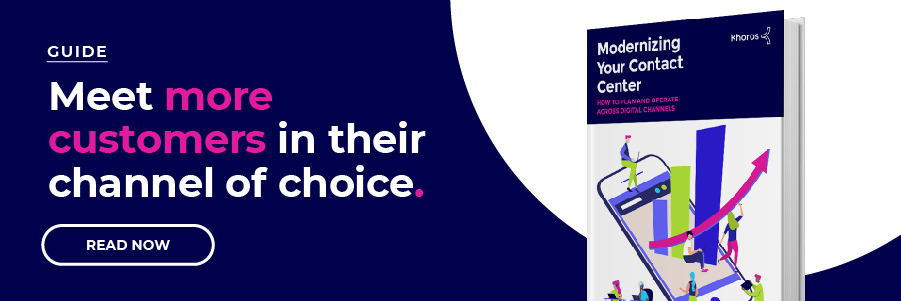 Logo
Logo
EXPERT INSIGHTS
Jan-13-2022
Using call deflection to improve customer experience
Khoros Staff
Introduction
New technologies are transforming the ways in which customers behave.
Customers are becoming increasingly informed, empowered, and demanding, and each has different preferences for communication. They want to interact with businesses in many different ways and have higher expectations of quality and standards.
To adapt to changing consumer behavior, many businesses are adjusting how they operate including moving from call-focused support to modern digital contact centers. By deflecting calls to digital channels, brands can improve the customer experience while lowering operational expenses.
If you’re interested in call deflection, this post will provide everything you need to know including what it is, why it’s important, and strategies for implementing this practice for your brand.
What is call deflection?
Call deflection is the process of redirecting customer calls to other channels to ensure your customers receive the information they are looking for in the most efficient and effective way. With call deflection businesses have the opportunity to present the channel that is best for the user, and on the proper device.
Why is call deflection important?
Call deflection helps streamline the shift from telephone interactions to digital channel interactions. A survey by McKinsey and Company found that brands who transition to digital customer service can reduce costs by 30% while increasing customer satisfaction by 19%. Modern customers demand fast and efficient customer service interactions, asynchronous support across different agents and communication channels. With a proper call deflection strategy, your business can begin their digital transformation and move customers to digital channels that provide a better user experience at lower operating costs.
What causes high call volume?
When a business experiences a customer service surge, call volume is one of the first metrics to soar through the roof. When call volume is high, wait times increase, and customer satisfaction drops. If you’re not set up the right way to handle an increase in volume, it can lead to big challenges for your contact center. Many brands also struggle to keep up with support requests during the holidays. A Shopify study found that support volume requests increase by 65% during the holiday season. High volume calls are painful for everyone involved and often creates a negative brand perception from both internal and external customers. Call centers not only have limited agents but these agents also have limited availability. Most representatives are only available from 8-5 on weekdays and customers have issues beyond these operational hours. Call deflection can help growing businesses through digital interactions. Businesses are able to better manage high call volume, and reduce wait time by giving customers the option to switch to a different digital channel.
How does call deflection work?
Call deflection works by redirecting customer calls to digital channels such as chat, email, or self-service options like FAQ pages and community forums. This powerful strategy takes the pressure off the phone lines by strategically diverting customer inquiries to other digital or messaging channels. The result is greater agent efficiency and improved customer satisfaction, as agents don’t get bogged down with the same repetitive requests and customers don’t waste time on hold.
In the McKinsey and Company report mentioned earlier, one company found there were 2,000 reasons for customers to contact their call center, but just sixty problems (3%) accounted for 65% of the total volume and 55% of their overall costs. Out of those 60 issues, only 15 had a solution available online. This means the brand could significantly reduce volume for these requests by implementing self service solutions for the other 45 common issues.
Providing customers with other support options like SMS, live chats, and self-service solutions — helps address low-touch customer service. Call deflection works by ensuring that customer calls that do come through are high-touch calls that aren’t able to be handled with other forms of customer support. As a result of call deflection, customers get what they need quickly and efficiently, and agents get to focus on more complex issues that require real-time support. Call deflection should not be confused with other techniques aiming to avoid interactions with customers, such as call forwarding. Call deflection allows the customer to be in control. It gives them the opportunity to switch to digital channels or proceed with the call.
What is call deflection rate?
Call deflection rate is the rate at which your alternative digital channels and self-service resources fulfill demand that would otherwise have needed to be taken care of by a call center agent. You can increase call deflection rate by offering customers more digital care options. This provides them with multiple ways to find a resolution to their questions and in turn helps improve agent efficiency.
Advantages of call deflection
Increases First Contact Resolution (FCR) metrics for customer inquiries
Increases Customer Satisfaction (CSAT) and Net Promoter Scores (NPS)
Reduces operation costs by utilizing low cost digital channels
Decreases the Average Handling Time (AHT) this includes wait times, call transfer times, and after call work
Reduces the amount of call backs and repetitive calls
Improves agent efficiency
Reduces call center attribution
Increases privacy for customers
Improved management of interactions for companies and creates a better customer journey

Call deflection strategies
Successful digital-first contact centers use a combination of call deflection strategies including self-service, messaging entry points, and proactive notifications to deflect inquiries and deliver better customer experiences. Here are few call deflection strategies and use cases:
1. Create self-service options
Most customers don’t want to have a conversation but instead want to solve their problems themselves with easy to find solutions. This is why customers often look for self-service options before contacting a brand's customer service directly. To make self-service as easy as possible for customers, businesses can consolidate FAQ pages, knowledge bases, status lookup portals, and forums with questions and answers into a single brand-owned community. This not only helps customers but it also helps brands save millions of dollars in call deflection.
Case Study: Dataiku, a leading AI and machine learning platform company, created an expansive online community with company-wide buy-in and contributions. In the first year, Dataiku logged 240k community visits — a 480% jump from the previous year — and they achieved more than $1 million in cost deflection savings. They also had an 82% accepted solutions rate.
2. Direct search traffic to Google’s Business Messages

When customers need to find information, they turn to Google, the most used search engine in the world. Google’s Business Messages is a mobile conversational channel that places messaging buttons on Google Maps, Search, and brand websites. This ensures that customers looking for your contact info see the option to message instead of call. This asynchronous messaging experience not only increases call deflection rates but it also delights customers and drives business results.
3. Deflect 1-800 number calls to messaging using Apple Chat Suggest

By using Chat Suggest with Apple Business Chat, brands have the ability to intercept customer behaviors that are about to become calls and offer them a convenient and inviting messaging option instead. This feature allows your customers to contact you through Apple Business Chat in the Messages app. This digital channel allows brands to reduce phone call volume. Messaging can often offer a better agent to customer concurrency ratio compared with voice. This also helps brands reduce their contact center operational costs.
Case Study: Midco, a regional cable provider, implemented both Google’s Business Messages and Apple Business Chat. Midco has realized a 73% increase in call deflection, resulting in reduced response times. Likewise, Midco has seen a 20% reduction of click-to-call 1-800 numbers.

4. Deflect calls by letting your customer choose their preferred digital channel
Businesses are now able to use a one-platform solution for all digital channel needs. This digital-first customer engagement platform allows for asynchronous conversations in whichever digital channel a customer chooses. With asynchronous messaging support agents and customers can use full conversation histories to recall previous interactions and, if necessary, pick up the discussion right where it left off. This increases FCR and reduces wasteful repeat interactions. It also allows for a more personalized customer experience which greatly contributes to increased customer satisfaction.
5. Use AI-powered bots to scale operations while deflecting calls
AI-powered chatbots can now detect customer intents and resolve inquiries with the right information and the right self-service content. These chatbots can help support agents and automate processes with AI to suggest the best response and intelligently tag conversations by intent to increase precision and personalization. This technology can improve over time with machine learning that refines intent detection and routing so that customers get the best possible resource to resolve their inquiry without ever having to make a call.
Promoting new digital interaction channels vs. traditional support channels
Pre-recorded messages and telephone lines with 1-800 extension numbers have long been the predominant channel for customer service. Brands often promote their 1-800 in emails, on website homepages, etc. However, this traditional support channel has never been more unpopular. Today’s customers want to get their questions answered with ease, without jumping through added hoops like navigating support menus over the phone or being forwarded to different agents just so they can re-explain their issue. Additionally, today’s customers value time more than ever before. In fact, 66% of customers feel that valuing their time is the most important part of a good customer experience.
The use of digital channels for customer service is becoming more widespread. It’s essential for businesses to promote their new digital channels so that customers know to use them. Call deflection is an efficient way to do so. When deploying call deflection, the priority is the customer’s experience, like with any initiative concerning their customer journey. With new digital interactions conversation history is kept, this helps solve interactions faster and offer a more personalized customer experience.
The importance of call deflection during COVID-19
The pandemic has made call deflection more important than ever. Businesses are experiencing high volumes of customer calls and finding it hard to keep up. Wait times have gone up to four hours in some industries. Many agents are working from home and are overwhelmed. Businesses are also impacted by call agents and other customer service representatives being out due to illness and shutdowns. Call deflection is an essential way to connect customers with the information they need. Due to the COVID-19 crisis, 75% of people are using digital channels for the first time and plan to continue using them when things ‘return to normal’. These new channels help brands save money, improve the customer experience, and alleviate agent workloads during these unprecedented times.

Should my business implement call deflection?
You’re probably wondering whether a call deflection strategy is right for your business — especially if you’re in the launch or early growth stage. Will it still help in such an early part of the process?
The answer is, yes. Call deflection can be preemptive. Questions and topics can be anticipated and addressed ahead of the call through other digital channels. Getting new customers accustomed to your digital channels starts a digital transformation that provides a better user experience with lower costs. Implementing call deflection has led to happier, more loyal customers who are more likely to make repeat purchases. Successful businesses understand how new digital channels and automation can modernize their contact center. The best contact centers align people and technology to build a digital-first service funnel.
Improve your customer experience with call deflection and Khoros
When your business is ready to start deflecting call inquiries and begin engaging with customers like never before, Khoros is here to help. From messaging, chat, and SMS, to owned and channel-based digital communities, Khoros helps brands harness the power of human connection across every digital interaction to stay all-ways connected.
Transform your contact center for the digital age.











